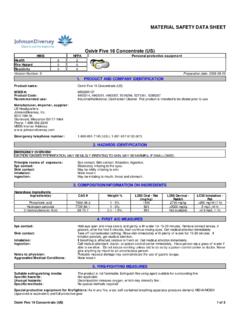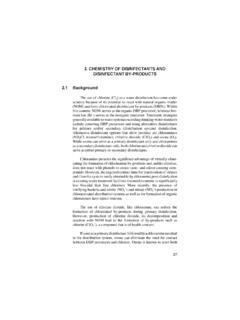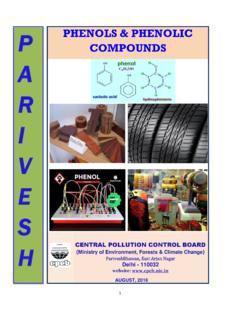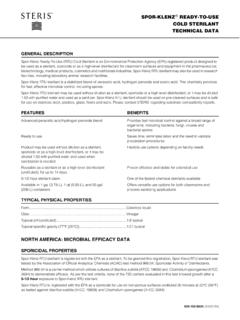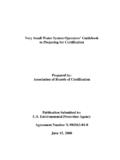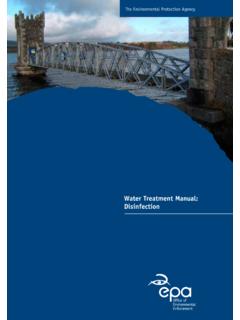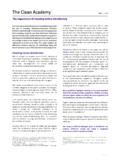Transcription of The Importance of Contact Times for Disinfectants
1 TECHNICAL BULLETIN TB034_07-2008_Rev0 The Importance of Contact Times for Disinfectants Situation: The number of hospital and community acquired infections continues to rise in North America and around the world. The use of Disinfectants is the backbone for infection control in healthcare, educational settings, correctional settings and emergency services. Infection Control Guidelines in North America generally state that surfaces such as countertops, over-the-bed tables, bedside tables, hand rails and other high touched surfaces be cleaned on a daily basis using an EPA or DIN registered disinfectant. However, the actual process for cleaning is rarely considered, the time needed to do the job correctly is rarely given and staffing limitations lead to inappropriate use of Disinfectants . A critical component of disinfection is prior cleaning. Prior cleaning is necessary to remove proteinaceous material and biofilms to allow the germicide to achieve adequate microbial inactivation.
2 The use of a product that provides excellent cleaning capabilities is paramount in ensuring effective disinfection. In addition, strict adherence to disinfectant Contact Times (the length of time the surface needs to remain wet) must be followed. However, current practices generally allow only time for a surface to be wiped once and allowed to air dry. For disinfection to occur, it is important for a product to keep the surface wet for the entire disinfection Contact time as noted on the label in order to achieve the claimed disinfection activity. What happens if Contact Times are Not Met? As experts in the appropriate use of Disinfectants we wanted to study what level of kill actually happens using the practices that are routinely used in facilities today - wipe once and allow the surface to air dry. The results were not surprising. The study compared six different chemistries: a Quaternary Ammonium Compound, a Quat-Alcohol blend, a Phenol, an Alcohol-Phenol blend, Bleach and Accelerated Hydrogen Peroxide.
3 First, the drying time was compared to the label Contact time . It was found that all products dried in less than 5 minutes with alcohol-based products drying significantly faster (less than 2 minutes) than the other chemistries. Products with Contact Times of 10-minutes (Quat, Phenol and Bleach) all dried within 3 4 minutes. Accelerated Hydrogen Peroxide formulations with 1 minute and 5 minute Contact Times dried within 3 4 minutes. Figure 1 provides a visual comparison of the data. The second phase of the study tested the efficacy of the products using their drying time to see what level of kill is achieved and if disinfection claims according the label were achieved. The results are outlined in Figures 2, 3 and 4 below. What can we Learn from the Study? Accelerated Hydrogen Peroxide was the only chemistry that was able to achieve disinfection using the drying time regardless of Contact time .
4 Facilities that do not achieve the appropriate Contact time for Disinfectants in accordance to the approved label Contact time may not be achieving the level of kill TECHNICAL BULLETIN TB034_07-2008_Rev0 required. Education is paramount to ensuring products are used appropriately. If staff using cleaning and disinfecting products do not have the basic understanding of best practices for cleaning within a healthcare facility there is a significant risk that the level of kill needed is not occurring. Furthermore, facilities that want to ensure that disinfection is in fact occurring should look at chemistries that have proven cleaning efficacy, the ability to kill in short Contact Times and also the ability to kill in within the length of time the product takes to dry. Table 1: Drying time versus Disinfectant Label Contact time Figure 2: Chemistries That Dry Before They Kill Chemistry Dry time Label claim Staphylococcus aureus Pseudomonas aeruginosa MRSA 17% IPA, quat 1 min 3 min 6 Quat (1:128) 3 min 10 min <2 <2 <2 60% IPA, quat 30 sec 1 min <2 <2 <2 70% ethanol, OPP 30 sec 1 min <4 Phenol, 1:128 3 min 10 min <2 <3 TECHNICAL BULLETIN TB034_07-2008_Rev0 Figure 3: Chemistries That Marginally Kill Before They Dry Chemistry Dry time Label claim Staphylococcus aureus Pseudomonas aeruginosa MRSA Bleach, 1:100 3 min 10 min 6 6 Figure 4: Chemistries That Kill Before They Dry Chemistry Dry time Label claim Staphylococcus aureus Pseudomonas aeruginosa MRSA AHP 3 min 1 min / 5 min References.
5 Surface Disinfectants and label claims: Realistically can Contact Times be met to achieve antimicrobial efficacy? CJIC 2008;23:49


